Periplasm - Study guides, Class notes & Summaries
Looking for the best study guides, study notes and summaries about Periplasm? On this page you'll find 80 study documents about Periplasm.
Page 2 out of 80 results
Sort by
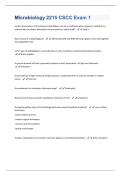
-
Microbiology 2215 CSCC Exam 1 Questions And Answers.
- Exam (elaborations) • 9 pages • 2024
- Available in package deal
-
- $7.99
- + learn more
portion that anchors LPS molecule in lipid bilayer, can act as endotoxin when organism is killed & it is released into circulation (stimulate immune system to attack itself) - Lipid A Basic structure of peptidoglycan - Alternating NAG and NAM forming a glycan chain held together by terapeptide chain a thin layer of peptidoglycan surrounded by an outer membrane containing lipopolysaccharides - Gram-negative A type of dormant cell that is generally resistant to heat, dessication, UV light an...

-
Med biochem - Exam 2 part 2 Questions And Answers All Correct
- Exam (elaborations) • 19 pages • 2023
- Available in package deal
-
- $13.49
- + learn more
Med biochem - Exam 2 part 2 Questions And Answers All Correct Gram positive bacterial cell envelope - ANS-has OM, peptidoglycan layer, cytoplasmic membrane (IM), then the cytoplasm - Cytoplasmic membrane: phospholipids and protein - PG - Techoic Acid - S-Layer Proteins Gram stain of bacterial cell envelopes - ANS-Primary stain of crystal violet and a counterstain of safranin. differentiates gram negative (pink) and gram positive (purple) Functions of bacterial cell envelopes - ANS-1. ...
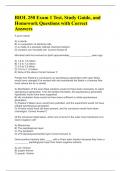
-
BIOL 250 Exam 1 Test, Study Guide, and Homework Questions with Correct Answers
- Exam (elaborations) • 23 pages • 2024
- Available in package deal
-
- $13.49
- + learn more
A pure culture A) is sterile. B) is a population of identical cells. C) is made of a precisely defined chemical medium. D) contains one microbial cell. Correct Answer B Microbial cells first evolved on Earth approximately ________ _______ years ago. A) 1.6 to 1.8 million B) 7.0 to 7.2 million C) 3.8 to 3.9 billion D) 10.5 to 11.5 billion E) None of the above Correct Answer C Predict how Pasteur's conclusions on spontaneous generation with swan flasks would have changed if he...
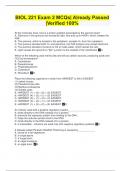
-
BIOL 221 Exam 2 MCQs| Already Passed |Verified 100%
- Exam (elaborations) • 7 pages • 2024
-
Available in package deal
-
- $9.99
- + learn more
At the molecular level, how is a proton gradient generated by the quinone loop? A. Electrons in the quinone are excited by light, and end up in NADH, which creates the PMF. B. The quinone, which is located in the periplasm, accepts H+ from the cytoplasm. C. The quinone donates both H+ and electrons, but FeS proteins only accept electrons. D. The quinone donates 2 protons to O2 to make water, which leaves the cell. E. Light causes the quinone to "flip" a proton to the outside of the membrane C ...
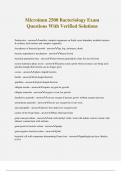
-
Microimm 2500 Bacteriology Exam Questions With Verified Solutions
- Exam (elaborations) • 14 pages • 2024
-
- $12.49
- + learn more
Microimm 2500 Bacteriology Exam Questions With Verified Solutions Prokaryotes - answersmallest, simplest organisms on Earth; most abundant; includes bacteria & archaea; lack nucleus and complex organelles four phases of bacterial growth - answerlag; log; stationary; death bacteria reproductive mechanism - answerbinary fission bacterial generation time - answertime between generations (time for one division) reason stationary phase exists - answerbacteria reach a point where resources are ...
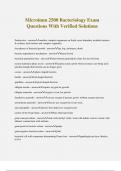
-
Microimm 2500 Bacteriology Exam Questions With Verified Solutions
- Exam (elaborations) • 14 pages • 2024
-
- $12.49
- + learn more
Microimm 2500 Bacteriology Exam Questions With Verified Solutions Prokaryotes - answersmallest, simplest organisms on Earth; most abundant; includes bacteria & archaea; lack nucleus and complex organelles four phases of bacterial growth - answerlag; log; stationary; death bacteria reproductive mechanism - answerbinary fission bacterial generation time - answertime between generations (time for one division) reason stationary phase exists - answerbacteria reach a point where resources are ...

-
BIOL 438 Nitrification Test Questions and Correct Answers
- Exam (elaborations) • 4 pages • 2024
-
Available in package deal
-
- $8.99
- + learn more
What is nitrification? What are the two steps of the process? Oxidation of ammonia (NH4+) to nitrite (NO2-) and Nitrate (NO3-) 1. ammonia oxidation to nitrite by ammonia-oxidizing bacteria (AOB) NH3 + O2 + ADP + Pi --> NO2- + H+ + ATP 2. nitrite oxidation to nitrate by nitrite-oxidizing-bacteria NO2- + O2 + ADP + Pi --> NO3- + ATP What is the produced ATP used for in the nitrite-oxidizing bacteria (NOBs) ? The ATP is used to fix CO2 in the calvin cycle. This allows for NOBs to grow on...

-
Med biochem - Exam 2 part 2 Questions And Answers All Correct
- Exam (elaborations) • 19 pages • 2023
-
- $12.99
- + learn more
Med biochem - Exam 2 part 2 Questions And Answers All Correct Gram positive bacterial cell envelope - ANS-has OM, peptidoglycan layer, cytoplasmic membrane (IM), then the cytoplasm - Cytoplasmic membrane: phospholipids and protein - PG - Techoic Acid - S-Layer Proteins Gram stain of bacterial cell envelopes - ANS-Primary stain of crystal violet and a counterstain of safranin. differentiates gram negative (pink) and gram positive (purple) Functions of bacterial cell envelopes - ANS-1. ...
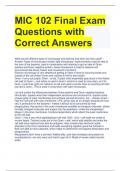
-
MIC 102 Final Exam Questions with Correct Answers
- Exam (elaborations) • 20 pages • 2023
-
Available in package deal
-
- $13.49
- + learn more
MIC 102 Final Exam Questions with Correct Answers What are the different types of microscopy and staining and when are they used? - Answer-Types of microscopy include: light microscopy- used primarily to get an idea of the form of the bacteria, used in combination with staining to get an idea of Gram positive and Gram negative protein. Green fluorescent is used to observe cell occurrences like binary fission and movement of proteins. Electron microscopy is very detailed at getting an idea of ...
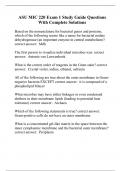
-
ASU MIC 220 Exam 1 Study Guide Questions With Complete Solutions
- Exam (elaborations) • 6 pages • 2023
-
- $10.99
- + learn more
Based on the nomenclature for bacterial genes and proteins, which of the following seems like a name for bacterial malate dehydrogenase (an important enzyme in central metabolism)? correct answer: Mdh The first person to visualize individual microbes was: correct answer: Antonie van Leewenhoek What is the correct order of reagents in the Gram stain? correct answer: Crystal violet, iodine, ethanol, safranin All of the following are true about the outer membrane in Gram-negative bacter...

That summary you just bought made someone very happy. Also get paid weekly? Sell your study resources on Stuvia! Discover all about earning on Stuvia


